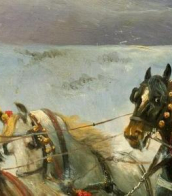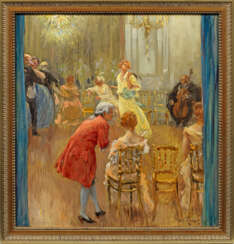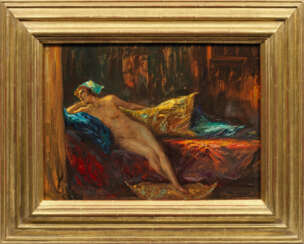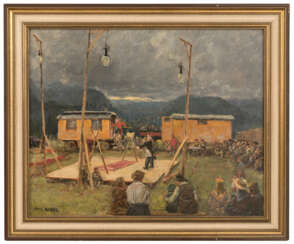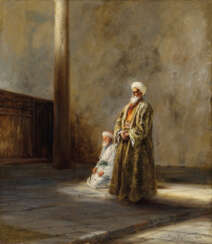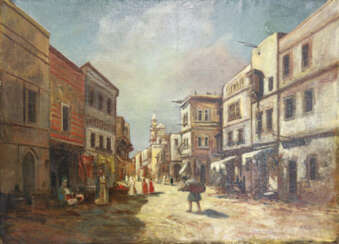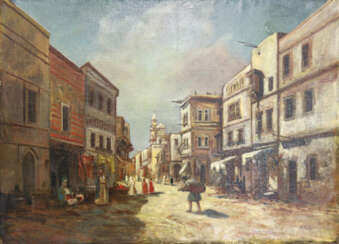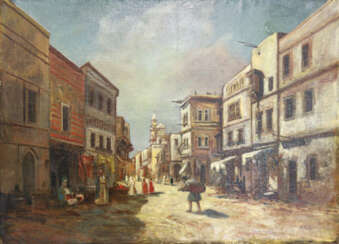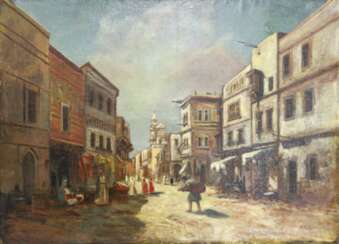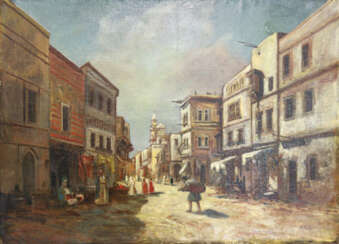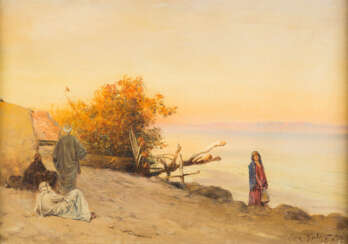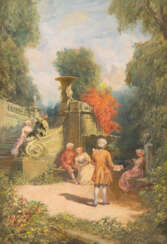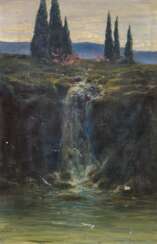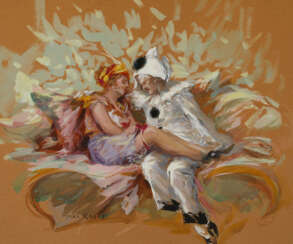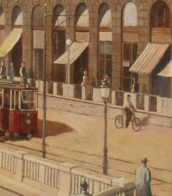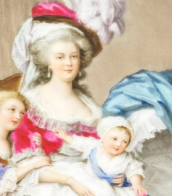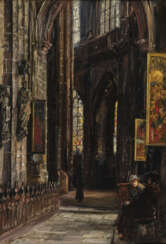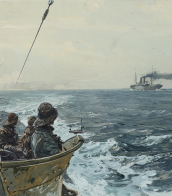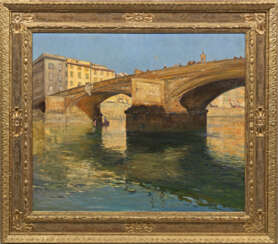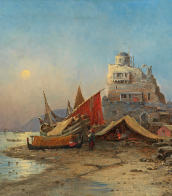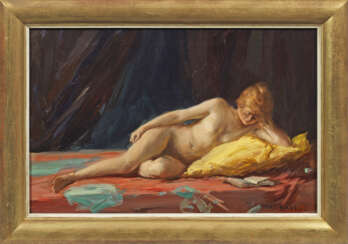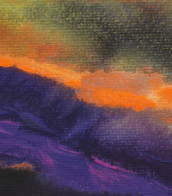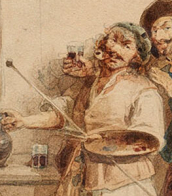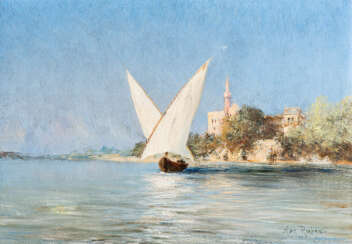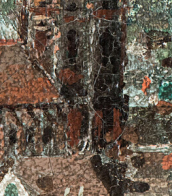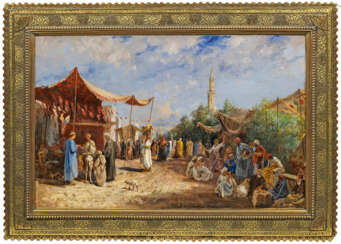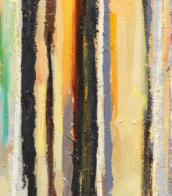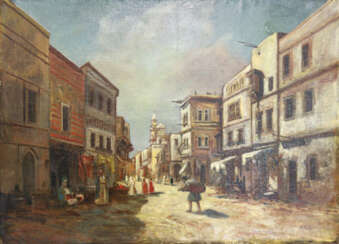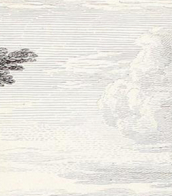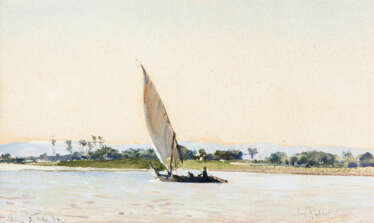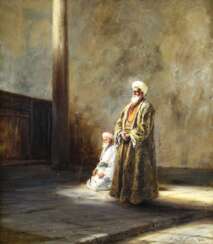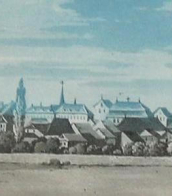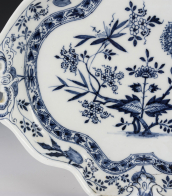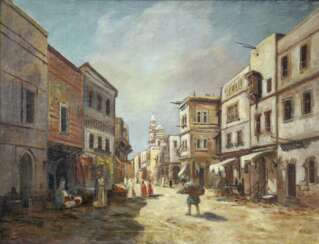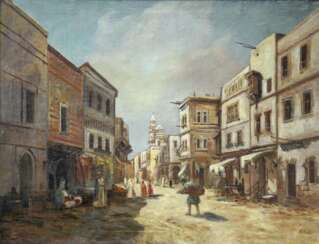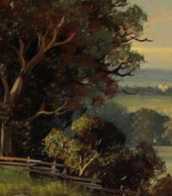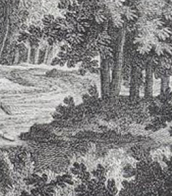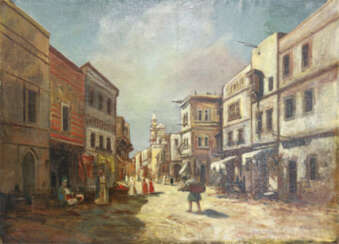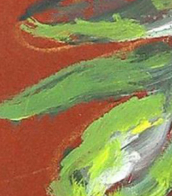max rabes (1868 - 1944)
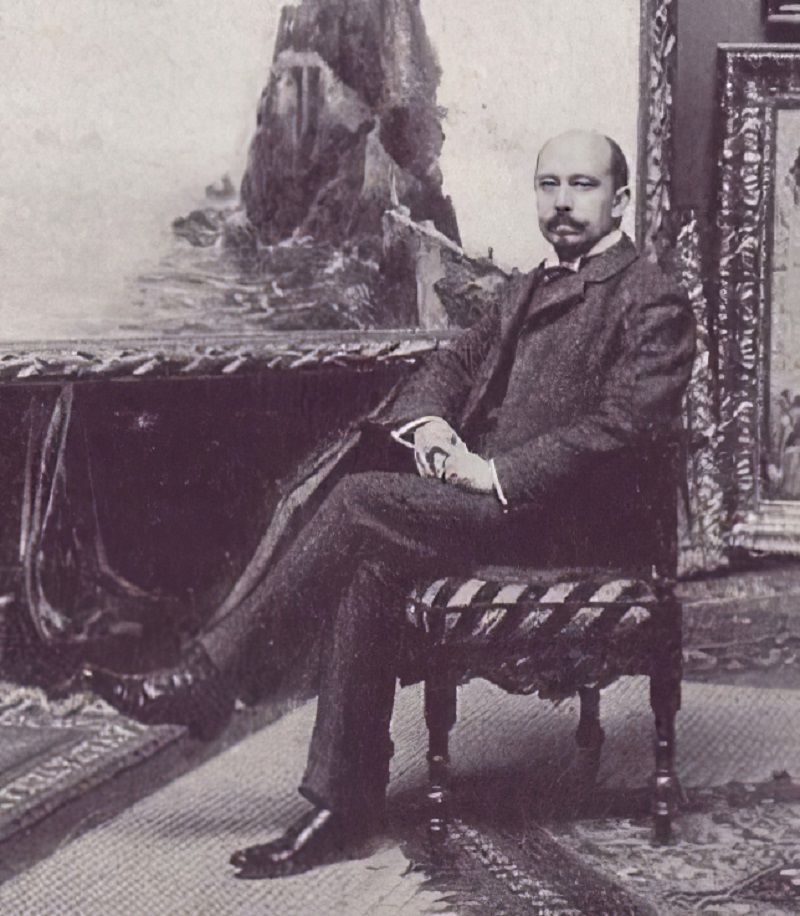
Max Friedrich Ferdinand Rabes was a German Impressionist painter. Although he is best remembered as an Orientalist painter, he rejected that label during his lifetime and wanted all of his works to be equally recognized. He was initially self taught, through making nature studies and sketches. Later, he took lessons from the landscape painter, Paul Graeb (1842–1892). He made numerous trips to North Africa and the Middle East. In 1898 he was invited to accompany Kaiser Wilhelm II on a trip to Istanbul and Palestine. He was appointed an honorary doctor and became a Professor at the Berlin University of the Arts. In 1899, he was awarded the Order of the Zähringer Lion. In 1914, he undertook a trip to the front lines in East Prussia. The following year, he was at the western front in Belgium and, in 1917, visited Verdun. In addition to his canvases, he did decorative work; including landscape murals at a castle in Lausitz (1901) and a villa in Iserlohn (1905), as well as ceiling paintings and allegorical murals at the Schauspielhaus in what is now Wrocław (1906-1908).
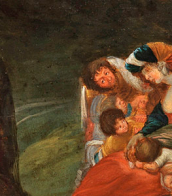

Max Friedrich Ferdinand Rabes was a German Impressionist painter. Although he is best remembered as an Orientalist painter, he rejected that label during his lifetime and wanted all of his works to be equally recognized. He was initially self taught, through making nature studies and sketches. Later, he took lessons from the landscape painter, Paul Graeb (1842–1892). He made numerous trips to North Africa and the Middle East. In 1898 he was invited to accompany Kaiser Wilhelm II on a trip to Istanbul and Palestine. He was appointed an honorary doctor and became a Professor at the Berlin University of the Arts. In 1899, he was awarded the Order of the Zähringer Lion. In 1914, he undertook a trip to the front lines in East Prussia. The following year, he was at the western front in Belgium and, in 1917, visited Verdun. In addition to his canvases, he did decorative work; including landscape murals at a castle in Lausitz (1901) and a villa in Iserlohn (1905), as well as ceiling paintings and allegorical murals at the Schauspielhaus in what is now Wrocław (1906-1908).
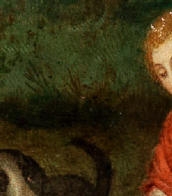

Max Friedrich Ferdinand Rabes was a German Impressionist painter. Although he is best remembered as an Orientalist painter, he rejected that label during his lifetime and wanted all of his works to be equally recognized. He was initially self taught, through making nature studies and sketches. Later, he took lessons from the landscape painter, Paul Graeb (1842–1892). He made numerous trips to North Africa and the Middle East. In 1898 he was invited to accompany Kaiser Wilhelm II on a trip to Istanbul and Palestine. He was appointed an honorary doctor and became a Professor at the Berlin University of the Arts. In 1899, he was awarded the Order of the Zähringer Lion. In 1914, he undertook a trip to the front lines in East Prussia. The following year, he was at the western front in Belgium and, in 1917, visited Verdun. In addition to his canvases, he did decorative work; including landscape murals at a castle in Lausitz (1901) and a villa in Iserlohn (1905), as well as ceiling paintings and allegorical murals at the Schauspielhaus in what is now Wrocław (1906-1908).


Max Friedrich Ferdinand Rabes was a German Impressionist painter. Although he is best remembered as an Orientalist painter, he rejected that label during his lifetime and wanted all of his works to be equally recognized. He was initially self taught, through making nature studies and sketches. Later, he took lessons from the landscape painter, Paul Graeb (1842–1892). He made numerous trips to North Africa and the Middle East. In 1898 he was invited to accompany Kaiser Wilhelm II on a trip to Istanbul and Palestine. He was appointed an honorary doctor and became a Professor at the Berlin University of the Arts. In 1899, he was awarded the Order of the Zähringer Lion. In 1914, he undertook a trip to the front lines in East Prussia. The following year, he was at the western front in Belgium and, in 1917, visited Verdun. In addition to his canvases, he did decorative work; including landscape murals at a castle in Lausitz (1901) and a villa in Iserlohn (1905), as well as ceiling paintings and allegorical murals at the Schauspielhaus in what is now Wrocław (1906-1908).
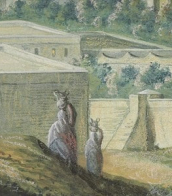

Max Friedrich Ferdinand Rabes was a German Impressionist painter. Although he is best remembered as an Orientalist painter, he rejected that label during his lifetime and wanted all of his works to be equally recognized. He was initially self taught, through making nature studies and sketches. Later, he took lessons from the landscape painter, Paul Graeb (1842–1892). He made numerous trips to North Africa and the Middle East. In 1898 he was invited to accompany Kaiser Wilhelm II on a trip to Istanbul and Palestine. He was appointed an honorary doctor and became a Professor at the Berlin University of the Arts. In 1899, he was awarded the Order of the Zähringer Lion. In 1914, he undertook a trip to the front lines in East Prussia. The following year, he was at the western front in Belgium and, in 1917, visited Verdun. In addition to his canvases, he did decorative work; including landscape murals at a castle in Lausitz (1901) and a villa in Iserlohn (1905), as well as ceiling paintings and allegorical murals at the Schauspielhaus in what is now Wrocław (1906-1908).


Max Friedrich Ferdinand Rabes was a German Impressionist painter. Although he is best remembered as an Orientalist painter, he rejected that label during his lifetime and wanted all of his works to be equally recognized. He was initially self taught, through making nature studies and sketches. Later, he took lessons from the landscape painter, Paul Graeb (1842–1892). He made numerous trips to North Africa and the Middle East. In 1898 he was invited to accompany Kaiser Wilhelm II on a trip to Istanbul and Palestine. He was appointed an honorary doctor and became a Professor at the Berlin University of the Arts. In 1899, he was awarded the Order of the Zähringer Lion. In 1914, he undertook a trip to the front lines in East Prussia. The following year, he was at the western front in Belgium and, in 1917, visited Verdun. In addition to his canvases, he did decorative work; including landscape murals at a castle in Lausitz (1901) and a villa in Iserlohn (1905), as well as ceiling paintings and allegorical murals at the Schauspielhaus in what is now Wrocław (1906-1908).
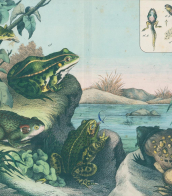

Max Friedrich Ferdinand Rabes was a German Impressionist painter. Although he is best remembered as an Orientalist painter, he rejected that label during his lifetime and wanted all of his works to be equally recognized. He was initially self taught, through making nature studies and sketches. Later, he took lessons from the landscape painter, Paul Graeb (1842–1892). He made numerous trips to North Africa and the Middle East. In 1898 he was invited to accompany Kaiser Wilhelm II on a trip to Istanbul and Palestine. He was appointed an honorary doctor and became a Professor at the Berlin University of the Arts. In 1899, he was awarded the Order of the Zähringer Lion. In 1914, he undertook a trip to the front lines in East Prussia. The following year, he was at the western front in Belgium and, in 1917, visited Verdun. In addition to his canvases, he did decorative work; including landscape murals at a castle in Lausitz (1901) and a villa in Iserlohn (1905), as well as ceiling paintings and allegorical murals at the Schauspielhaus in what is now Wrocław (1906-1908).
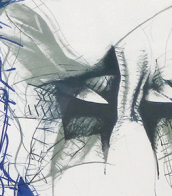

Max Friedrich Ferdinand Rabes was a German Impressionist painter. Although he is best remembered as an Orientalist painter, he rejected that label during his lifetime and wanted all of his works to be equally recognized. He was initially self taught, through making nature studies and sketches. Later, he took lessons from the landscape painter, Paul Graeb (1842–1892). He made numerous trips to North Africa and the Middle East. In 1898 he was invited to accompany Kaiser Wilhelm II on a trip to Istanbul and Palestine. He was appointed an honorary doctor and became a Professor at the Berlin University of the Arts. In 1899, he was awarded the Order of the Zähringer Lion. In 1914, he undertook a trip to the front lines in East Prussia. The following year, he was at the western front in Belgium and, in 1917, visited Verdun. In addition to his canvases, he did decorative work; including landscape murals at a castle in Lausitz (1901) and a villa in Iserlohn (1905), as well as ceiling paintings and allegorical murals at the Schauspielhaus in what is now Wrocław (1906-1908).
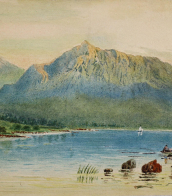

Max Friedrich Ferdinand Rabes was a German Impressionist painter. Although he is best remembered as an Orientalist painter, he rejected that label during his lifetime and wanted all of his works to be equally recognized. He was initially self taught, through making nature studies and sketches. Later, he took lessons from the landscape painter, Paul Graeb (1842–1892). He made numerous trips to North Africa and the Middle East. In 1898 he was invited to accompany Kaiser Wilhelm II on a trip to Istanbul and Palestine. He was appointed an honorary doctor and became a Professor at the Berlin University of the Arts. In 1899, he was awarded the Order of the Zähringer Lion. In 1914, he undertook a trip to the front lines in East Prussia. The following year, he was at the western front in Belgium and, in 1917, visited Verdun. In addition to his canvases, he did decorative work; including landscape murals at a castle in Lausitz (1901) and a villa in Iserlohn (1905), as well as ceiling paintings and allegorical murals at the Schauspielhaus in what is now Wrocław (1906-1908).
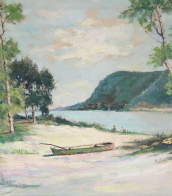

Max Friedrich Ferdinand Rabes was a German Impressionist painter. Although he is best remembered as an Orientalist painter, he rejected that label during his lifetime and wanted all of his works to be equally recognized. He was initially self taught, through making nature studies and sketches. Later, he took lessons from the landscape painter, Paul Graeb (1842–1892). He made numerous trips to North Africa and the Middle East. In 1898 he was invited to accompany Kaiser Wilhelm II on a trip to Istanbul and Palestine. He was appointed an honorary doctor and became a Professor at the Berlin University of the Arts. In 1899, he was awarded the Order of the Zähringer Lion. In 1914, he undertook a trip to the front lines in East Prussia. The following year, he was at the western front in Belgium and, in 1917, visited Verdun. In addition to his canvases, he did decorative work; including landscape murals at a castle in Lausitz (1901) and a villa in Iserlohn (1905), as well as ceiling paintings and allegorical murals at the Schauspielhaus in what is now Wrocław (1906-1908).


Max Friedrich Ferdinand Rabes was a German Impressionist painter. Although he is best remembered as an Orientalist painter, he rejected that label during his lifetime and wanted all of his works to be equally recognized. He was initially self taught, through making nature studies and sketches. Later, he took lessons from the landscape painter, Paul Graeb (1842–1892). He made numerous trips to North Africa and the Middle East. In 1898 he was invited to accompany Kaiser Wilhelm II on a trip to Istanbul and Palestine. He was appointed an honorary doctor and became a Professor at the Berlin University of the Arts. In 1899, he was awarded the Order of the Zähringer Lion. In 1914, he undertook a trip to the front lines in East Prussia. The following year, he was at the western front in Belgium and, in 1917, visited Verdun. In addition to his canvases, he did decorative work; including landscape murals at a castle in Lausitz (1901) and a villa in Iserlohn (1905), as well as ceiling paintings and allegorical murals at the Schauspielhaus in what is now Wrocław (1906-1908).
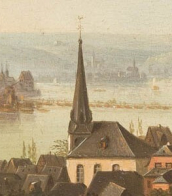

Max Friedrich Ferdinand Rabes was a German Impressionist painter. Although he is best remembered as an Orientalist painter, he rejected that label during his lifetime and wanted all of his works to be equally recognized. He was initially self taught, through making nature studies and sketches. Later, he took lessons from the landscape painter, Paul Graeb (1842–1892). He made numerous trips to North Africa and the Middle East. In 1898 he was invited to accompany Kaiser Wilhelm II on a trip to Istanbul and Palestine. He was appointed an honorary doctor and became a Professor at the Berlin University of the Arts. In 1899, he was awarded the Order of the Zähringer Lion. In 1914, he undertook a trip to the front lines in East Prussia. The following year, he was at the western front in Belgium and, in 1917, visited Verdun. In addition to his canvases, he did decorative work; including landscape murals at a castle in Lausitz (1901) and a villa in Iserlohn (1905), as well as ceiling paintings and allegorical murals at the Schauspielhaus in what is now Wrocław (1906-1908).
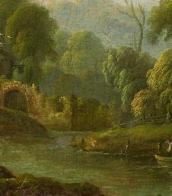

Max Friedrich Ferdinand Rabes was a German Impressionist painter. Although he is best remembered as an Orientalist painter, he rejected that label during his lifetime and wanted all of his works to be equally recognized. He was initially self taught, through making nature studies and sketches. Later, he took lessons from the landscape painter, Paul Graeb (1842–1892). He made numerous trips to North Africa and the Middle East. In 1898 he was invited to accompany Kaiser Wilhelm II on a trip to Istanbul and Palestine. He was appointed an honorary doctor and became a Professor at the Berlin University of the Arts. In 1899, he was awarded the Order of the Zähringer Lion. In 1914, he undertook a trip to the front lines in East Prussia. The following year, he was at the western front in Belgium and, in 1917, visited Verdun. In addition to his canvases, he did decorative work; including landscape murals at a castle in Lausitz (1901) and a villa in Iserlohn (1905), as well as ceiling paintings and allegorical murals at the Schauspielhaus in what is now Wrocław (1906-1908).
